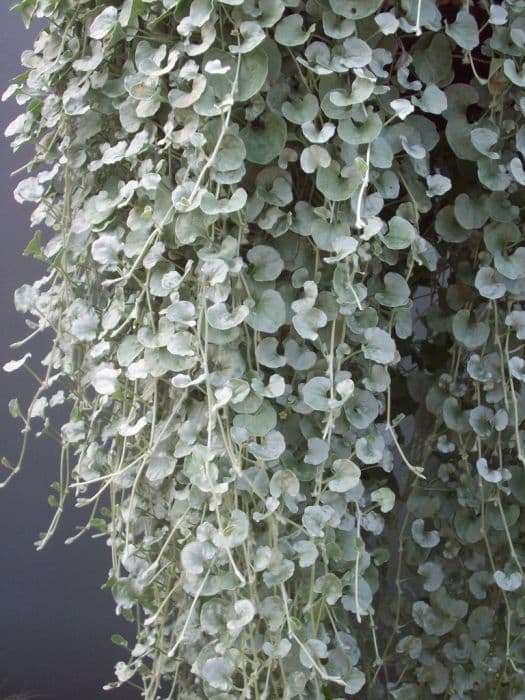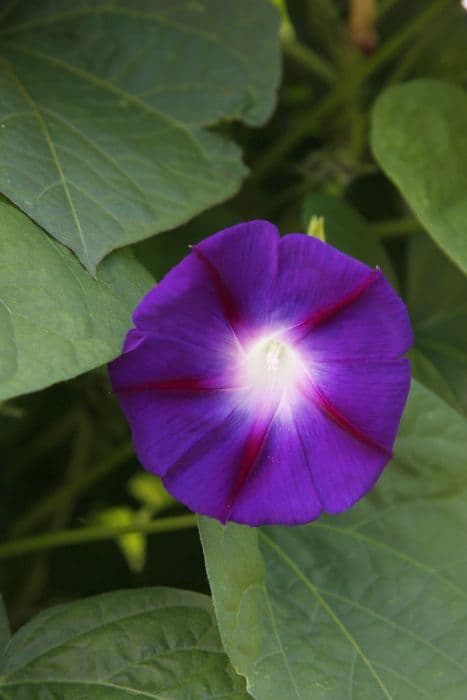Silver Ponyfoot Dichondra argentea 'Silver Falls'

ABOUT
Silver Falls is known for its striking trailing foliage. Each individual leaf of this plant is small and heart-shaped, with a soft, velvet-like texture. The leaves are distinctive for their shimmering silver hue, which can give the plant a whimsical, cascading appearance. This coloration allows it to stand out in gardens and hanging baskets, providing a sharp contrast to green foliage and colorful flowers it may accompany. In addition, the stems of Silver Falls are thin and delicate, allowing the leaves to drape gracefully over the sides of containers or along the ground if used as ground cover. It can create a flowing effect much like a silver waterfall, lending to its common name. The overall impression of Silver Falls is one of elegance and delicate beauty, with its shimmering foliage catching the light and adding sparkle to its environment.
About this plant
 Names
NamesFamily
Convolvulaceae.
Synonyms
Silver Ponyfoot, Silver Nickel Vine, Silver Dichondra, Silver Falls.
Common names
Dichondra argentea 'Silver Falls'.
 Toxicity
ToxicityTo humans
Silver Ponyfoot, commonly known as Dichondra argentea 'Silver Falls', is generally not considered toxic to humans. There is no widespread evidence or reports suggesting that this ornamental plant causes poisoning when touched or ingested. Therefore, accidental ingestion of Silver Ponyfoot is unlikely to result in symptoms of poisoning or serious consequences for humans.
To pets
Silver Ponyfoot is also considered non-toxic to pets. It is not known to cause any harmful effects if pets come into contact with or ingest parts of the Dichondra argentea 'Silver Falls'. Consequently, pet owners usually do not need to worry about their animals experiencing symptoms of poisoning from this specific plant.
 Characteristics
CharacteristicsLife cycle
Perennials
Foliage type
Evergreen
Color of leaves
Silver
Height
2-3 inches (5-7.6 cm)
Spread
4-6 feet (1.2-1.8 meters)
Plant type
Creeper
Hardiness zones
10
Native area
Central America
Benefits
 General Benefits
General Benefits- Drought Tolerance: ‘Silver Falls’ can withstand periods of low water, making it suitable for xeriscaping and drought-prone areas.
- Heat Resistance: It thrives in hot temperatures, making it an excellent choice for warm climates.
- Low Maintenance: Requires minimal care once established, making it ideal for gardeners seeking low-maintenance landscaping.
- Attractive Foliage: The silver foliage provides a striking visual contrast in gardens and containers.
- Trailing Habit: Perfect for hanging baskets, containers, and as a groundcover, due to its cascading growth habit.
- Fast Growing: It covers ground quickly, which can help prevent soil erosion and suppress weeds.
- Versatility: Suitable for various garden styles, including modern, Mediterranean, and cottage gardens.
- Pest Resistance: Generally resistant to pests, reducing the need for chemical interventions.
 Medical Properties
Medical PropertiesThis plant is not used for medical purposes.
 Air-purifying Qualities
Air-purifying QualitiesThis plant is not specifically known for air purifying qualities.
 Other Uses
Other Uses- Ground cover for terrariums: Silver Falls can be used inside terrariums to create a cascading or trailing effect over rocks and other features. Its tolerance for low light makes it suitable for enclosed ecosystems.
- Living mulch: In a garden setting, it can serve to cover the soil, conserving moisture and suppressing weeds due to its dense foliage.
- Jewelry and decoration: Craft enthusiasts sometimes use the delicate leaves and trailing stems of Silver Falls to create ornamental pieces like living necklaces or added décor for special occasions.
- Photography props: Its silvery foliage can add texture and contrast when used as a backdrop or feature in macro photography.
- Fairy gardens: Ideal for fairy or miniature gardens, its small leaves and draping habit can simulate miniature trees or waterfalls, enhancing the mystical ambiance of these small-scale landscapes.
- Seasonal displays: Can be incorporated into autumn and winter displays, where the silver tones blend well with seasonal décor such as pumpkins and pine cones.
- Tablescapes: Used as part of table arrangements for weddings or events, Silver Falls adds a touch of natural elegance and can drape over the sides of centerpieces.
- Fashion runway decor: Occasionally used to embellish fashion runways, providing a natural yet sophisticated edge to the environment.
- Green roofing: Suitable for planting on green roofs due to its drought tolerance and low-growing habitat, contributing to urban biodiversity and building insulation.
- Education: Silver Falls can be used in schools or educational programs to teach children about plant growth habits, trailing versus climbing plants, and silver foliage adaptations.
Interesting Facts
 Feng Shui
Feng ShuiSilver Falls is not used in Feng Shui practice.
 Zodiac Sign Compitability
Zodiac Sign CompitabilitySilver Falls is not used in astrology practice.
 Plant Symbolism
Plant Symbolism- Endurance: The 'Silver Falls' plant is known for its hardiness and ability to withstand drought, making it symbolic of endurance and survival.
- Purity: The silvery foliage of the Dichondra 'Silver Falls' can represent purity, akin to the color's association in many traditions and cultures.
- Growth: Given its trailing habit and vigorous growth, this plant can symbolize growth, expansion, and the idea of striving for greater things.
- Flexibility: The plant's cascading nature and resilience to various growing conditions can also symbolize adaptability and flexibility in life.
 Water
WaterSilver Ponyfoot should be watered thoroughly, allowing the top layer of soil to dry out slightly between waterings, which typically means watering once a week. During the active growing season in spring and summer, you might need to water more frequently, especially if the plant is outdoors in full sun or in a hanging basket where soil dries out faster. During winter, reduce watering to every other week or when the soil is dry to the touch. A good rule of thumb is to provide approximately half a gallon per watering for a standard-sized hanging basket or pot, ensuring even soil moisture without waterlogging.
 Light
LightSilver Ponyfoot thrives in full to partial sunlight. The ideal spot for this plant would be a location where it receives at least 4 to 6 hours of direct sunlight each day. It can tolerate some shade, but its silver foliage will be most vibrant when it's exposed to plenty of bright light. Avoid deep, full shade locations, as this can lead to leggy growth and reduced foliage quality.
 Temperature
TemperatureSilver Ponyfoot prefers temperatures between 60 to 75 degrees Fahrenheit but can survive in temperatures as low as 50 degrees Fahrenheit and as high as 90 degrees Fahrenheit. Avoid exposing the plant to temperatures below 50 degrees Fahrenheit, as cold temperatures can damage the foliage. Ideally, maintain a consistent temperature to promote healthy growth and avoid sudden drops which can be stressful for the plant.
 Pruning
PruningSilver Ponyfoot may need occasional pruning to maintain its shape and encourage fuller, bushier growth. Pruning is best done in the spring or early summer before new growth begins. Trim back leggy stems as needed, which can be quite rarely, and remove any dead or damaged foliage to keep the plant looking its best. You can prune up to one-third of the plant to promote healthier, denser growth.
 Cleaning
CleaningAs needed
 Soil
SoilSilver Ponyfoot thrives in well-draining soil with a mix of potting soil, perlite, and peat moss or coconut coir to retain some moisture without getting waterlogged. A pH between 6.0 and 7.5 is ideal for this plant.
 Repotting
RepottingSilver Ponyfoot should be repotted every 1-2 years or when it outgrows its container, to refresh the soil and encourage continued growth.
 Humidity & Misting
Humidity & MistingSilver Ponyfoot prefers moderate humidity levels but is quite tolerant and can adapt to lower humidity conditions typically found in home environments.
 Suitable locations
Suitable locationsIndoor
Place Silver Ponyfoot in bright, indirect light and well-draining soil indoors.
Outdoor
Plant Silver Ponyfoot in full sun to part shade and well-draining soil.
Hardiness zone
9-11 USDA
 Life cycle
Life cycleSilver Falls, or Dichondra argentea 'Silver Falls', begins its life as a seed which, when sown in warm soil, germinates within 2 to 3 weeks under ideal conditions. The seedling stage follows, marked by the emergence of kidney-shaped, silver-foliaged leaves on slender stems. As it enters the vegetative stage, the plant starts to develop a trailing habit, rapidly spreading and forming a dense ground cover or cascading over the edges of containers. Flowering is relatively inconspicuous with small, yellow-green flowers that may appear under longer day-lengths during its growth. After pollination, the flowers may set small fruits containing seeds, but propagating through cuttings is more common due to the difficulty in collecting seeds. The plant is perennial in warm climates, living for several years, but is often grown as an annual in cooler regions where it completes its life cycle within one growing season.
 Propogation
PropogationPropogation time
Spring-Early Summer
Propogation: The most popular method of propagating Silver Falls, or Dichondra argentea 'Silver Falls', is by cuttings. Ideally, this should be done during the warmer months when the plant is actively growing, typically from spring to early summer. To propagate, select a healthy stem and cut a 4- to 6-inch segment using a clean, sharp pair of scissors or secateurs. Remove the lower leaves to expose a few nodes where roots will eventually grow. The cut end can be dipped in rooting hormone powder to encourage root development, though this is optional. The cutting should then be placed in a well-draining soil mix or a container with water. Keep the soil consistently moist but not waterlogged, and place the cutting in a warm spot with indirect sunlight. Roots should start to form within a few weeks, after which the new plant can be transferred to a larger pot or its final growing location.

